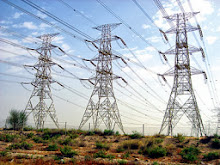Commutator Action in Dc generator
Commutator Action
The commutator converts the AC voltage generated in the rotating loop
into a DC voltage. It also serves as a means of connecting the brushes
to the rotating loop. The purpose of the brushes is to connect the
generated voltage to an external circuit. In order to do this, each
brush must make contact with one of the ends of the loop. Since the loop
or armature rotates, a direct connection is impractical. Instead, the
brushes are connected to the ends of the loop through the commutator.
| Fig(1) Commutator Segments and Brushes |
In a simple one-loop generator, the commutator is made up of two
semicylindrical pieces of a smooth conducting material, usually copper,
separated by an insulating material, as shown in Fig(1). Each half of
the commutator segments is permanently attached to one end of the
rotating loop, and the commutator rotates with the loop. The brushes,
usually made of carbon, rest against the commutator and slide along the
commutator as it rotates. This is the means by
which the brushes make contact with each end of the loop.
Each brush slides along one half of the commutator and then along the
other half. The brushes are positioned on opposite sides of the
commutator; they will pass from one commutator half to the other at the
instant the loop reaches the point of rotation, at which point the
voltage that was induced reverses the polarity. Every time the ends of
the loop reverse polarity, the brushes
switch from one commutator segment to the next. This means that one
brush is always positive with respect to another. The voltage between
the brushes fluctuates in amplitude (size or magnitude) between zero and
some maximum value, but is always of the same polarity (Fig(2)). In
this manner, commutation is accomplished in a DC generator.
Fig(2) Commutation in a DC Generator
|
One important point to note is that, as the brushes pass from one
segment to the other, there is an instant when the brushes contact both
segments at the same time. The induced voltage at this point is zero. If
the induced voltage at this point were not zero, extremely high
currents would be produced due to the brushes shorting the ends of the
loop together. The point at which the
brushes contact both commutator segments, when the induced voltage is
zero, is called the "neutral plane."










0 comments:
Post a Comment